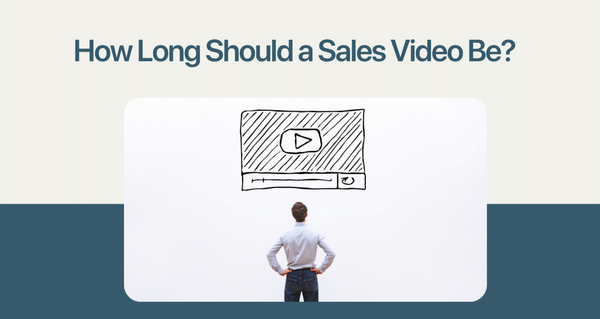"Get prospects into the pipeline" "filling pipelines with leads" are some of the phrases thrown around a lot by sales managers. However, it's not just a buzzword, rather an important sales term that makes a huge difference in increasing sales efficiency.
It is safe to say that if you are still not using the sales pipeline, you are potentially losing money and failing to understand the strengths and weaknesses of your sales process.
So it's no wonder that the pipeline holds much weightage.
Let's dive in to find out how you can strengthen your sales pipeline with videos!
What on Earth is the Sales Pipeline, and Why do Managers Love it so Much?
'Pipeline' is more than a buzzword. Rather, It's a useful and crucial sales management tool that helps with sales operations and processes. So, it's not surprising that managers love it so much! The pipeline in sales process makes the job easy.
The sales pipeline process helps you visualize your entire lead position. It gives a clear picture of your prospect's status and where they currently stand and gives you an idea of the amount of effort you need to spend on each prospect.
Pipeline gives you insights into your entire sales efforts, and you can be a champion sales rep if you follow the process smartly.
Important Questions to Ask During Sales Pipeline Process
Sales pipeline gives a summary of the leads that are upcoming and leads that are available.
The pipeline provides visibility into which activities in the sales process are translating into conversions.

Missed opportunities or missed stages of your prospect's journey (from lead to customer) can be identified and corrected for increased ROI.
A sales pipeline should always have a process to positively affect the conversion rates.
1. Who is in the pipeline?
Are they new leads, or are they existing customers? For example, the person contacting you might be researching for an article, reviewing what your company offers to all of its potential customers; targeting specific people within your company (e.g., "sales manager"); or looking to buy based on what they know about the product and how it's priced.
2. What is the stage in your sales process? What makes you move a lead from one stage to another?
For example, do you have thresholds that must be met before moving forward with a purchase order for an existing customer? Or are there different phases of service that depend on specific criteria being met?
For example, is the person calling you about a large order or a small one about to inquire or looking for answers? How long has the lead been in your system?
3. What are they actually contacting you about?
Do they have questions specific to what you do, or are they asking for more information before making a final purchase decision? Is this something you would normally follow up with on your own, or are you being asked to do so?
4. Why are they in the pipeline? What brought them to you in the first place?
Do you have a marketing campaign that's bringing leads or company referrals through to the next stage of the pipeline, or is this person specifically targeted for what they're inquiring about right now?
5. Are there certain products or services for which leads decline as you move them forward?
Is there something you could do to make them change their mind?
6. Are you selling to the right people?
If you're trying to sell custom-made furniture and only 5% of your leads are ready to buy, do you need to adjust your marketing campaign so that it attracts more customers who are likely to buy at the first stage of contact?

Sales Funnel Vs. Sales Pipeline
Sales Pipeline
Sales pipeline is a linear progression of stages that a new lead or prospect goes through from the first point of contact with your company to becoming a customer.

Sales funnel
A sales funnel looks at each stage of the customer's process with your company to see how many have moved through it successfully.

It's what many people think of when they imagine a funnel, which is how some people get confused between these two concepts.
In fact, some companies make it even more confusing by using the terms "sales funnel" and "marketing funnel," which is exactly the same thing for all intents and purposes.
A sales pipeline is an approach to managing your customer's journey. It will help you understand what leads are coming in, the stage they are currently at, and how much their prospects have grown or shrunk.
Sales Pipeline Stages - 7 Steps
Before a prospect becomes a successful customer, they fall under various stages of the sales pipeline. The stages vary from discovery all the way through making a sale.
Here are the key stages of a sales pipeline.
Remember, the goal in tracking leads through your sales pipeline is to quickly identify which leads are ready to buy and how likely they are to actually follow through on their potential purchase. The more information you have, the better.
If someone has gone from one stage to another, it means that they are closer to making a deal.
By analyzing your pipeline at each stage, you can also see what's working and what isn't:
1. Prospecting/Lead Generation Stage
The first stage of the sales pipeline is known as prospecting. This is the initial stage of the sales cycle where one has to find new clients/customers who are willing to buy or subscribe to their services.

The first stage or prospecting phase can succeed only if you research your target customer profile, identify potential buyers and approach them with the right message.
This is the only way to increase your chances of winning customers in this highly competitive world.
The ability to build rapport with new customers will play a huge role in determining whether you will be able to convert them into buying customers or not.
In addition, you can greatly influence buyers during this stage by providing information on what they need and how your products and services will meet those needs with video outreach.
Video prospecting is a technique in which the sales teams record and send across a short and very personalized video for the prospects to see.
Using videos for emails helps you humanize the process of prospecting by putting a face and name to the content.
Personalizing and humanizing the content are two of the aspects that are usually omitted when sending regular emails for sales outreach.
Besides that, the creativity and approach used behind the creation of these videos have a lot to do with its success.
2. Qualified lead
Once you've generated leads, the next phase in the sales pipeline is qualifying them. But, again, your pipeline is on fire if you have qualified leads coming in consistently because it means you're hot on converting new prospects!
Qualified leads should fit your target market criteria, require your product, and be able and motivated to buy. Qualified leads are people that are ready to buy right now.

They've taken the first steps by filling out an inquiry or completing a demo, so now they need extra persuading.
To move your leads or prospects one step closer to winning the deal, offer some value to them, like an e-book, send a personalized video message, and invite them to a webinar or an event.
Did you know that personalized video emails have the power to create more impact and convert a lead faster than a boring text email?
The diversity of use cases that videos tend to serve is huge and incredible. There are different genres of videos like explainer videos, how-to guides, product and service videos, etc.
These videos tend to take into account the pain points of the customers and show them how different features of the product that you are offering can solve the problem. Doing this, besides the problem getting solved, there's also a surge in the conversion rates.
3. Demo stage
Once your qualified leads respond positively, it's time to lead the way to the next stage.
Call your prospects and invite them to see firsthand how your products and services can serve them. Invite them for a demo or share demo videos with them via video emails.

Don't forget to draft a personalized offer or create a trial period that lets your prospects play around with your products and services and learn about the features and superior quality you offer.
Also Read: Sales Demo
4. Sending a Proposal
Your business won't get big cheques and pay clients without closing the deal. To close a deal, you need to come up with shiny proposals. Start by drafting interesting proposals that include this pipeline.

When every proposal you draft is different to every single client, depending on their requirement; likewise, your email content needs to be personalized to suit the intent.
What's better than sending a personalized video email? It both humanizes and personalizes your content, making your prospect more interested in the proposal you send.
Here is a list of things you should keep in mind while drafting your video proposal
- Address your prospect's key pain points
- Your solution with specs
- Plans & pricing
- Scope of work
- Implementation plan with timelines
- Terms & conditions
- Also, add anything that you think create values to your prospect's
Add CTA's to your video email, so your prospect may respond promptly with their intent.
You can also add various deep personalization options in Videoform, like adding an interesting thumbnail or integrating with your CRM.
Analytics gives you insights into the video email statistics, open rates, and play rates.
5. The Negotiation Stage
Once the proposal sounds good to your prospects, they would want to negotiate. They can respond with the meeting time via the Calendly meeting invite you have added in your video email CTA.
When the time for a meeting arrives, make sure you add value and positively negotiate your terms and conditions so as to close the deal.

Discuss the scope of work and manage expectations to mutually agree on a price and close the deal.
Also Read: Top 5 Sales Cadence Examples: Improve Your Conversions Dramatically
6. Signing the Contract
The penultimate stage in the sales pipeline is closing the deal or signing the contract.
When you and your prospects both agree to the terms and conditions in your negotiation meeting, it's time to seal the deal with a contract.

Make a solid contract with all the agreed terms and get it signed as soon as possible.
Make your process interesting by using a video to let your prospects know that you have drafted the contract and are ready to take it to the next level.
7. Cross-Selling Opportunities & Retaining Client
The sale is not over with signing the contract. Retaining clients is of utmost important to generate continuous revenue from your client.
Your client can still give you more business, and you have a greater cross-selling advantage with converted clients.

All you have to do is provide exemplary customer service and keep feeding your clients new information and create value.
Touch base with your clients once in a while to check on how they are doing and ask for feedback. Create interesting video messages to pass the information on what's happening with their project and what more you can do for them.
Offer value via your video messages. These activities are a sure shot for getting new business from your old clients.
See Growth With Personalization
While recording a video for sales prospecting, delivering the message with a personalized touch is very important.
Personalization helps you stand out in the inbox leading to an increase in the open rate, click-through rate, and also the response rate.
When your prospect sees that a video is especially made for them, it intrigues them into watching the same.
People in this digital era have a very selective hearing capability and tend to filter the things that reach them.
The entire difference that exists between getting noticed and ignored is of being relevant on a personal basis.
Even if you've written a piece of content that is relevant, it is possible that when your prospects know that the copy is not created for them, they might refuse to convert.
But, videos and prospecting through them can individualize the assets to each viewer.
Now that we spoke a lot about using videos in pitching and proposals give Videoform a try and see for yourself the impact it can create in converting leads to paying clients.





